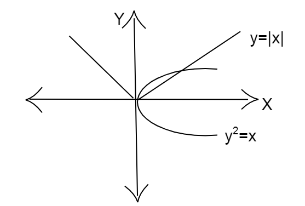
The area enclosed between the ${y^2} = x$ and $y = |x|$ is
A) $\dfrac{1}{3}$
B) $\dfrac{2}{3}$
C) $1$
D) $\dfrac{1}{6}$
Answer
466.2k+ views
Hint: The area between two curves can be found using definite integral. Since the curves are expressed in terms of $y =
f(x)$, we can integrate with respect to $x$. No specific interval is given. So we can take the unit interval $(0,1)$.
Formula used: If we have two curves $y = f(x)$ and $y = g(x)$ such that $f(x) > g(x)$ then the area between them bounded by the horizontal lines $x = a,x = b$ is given by
$A = \int\limits_a^b {(f(x) - g(x))dx} $
Complete step-by-step solution:
We are given the curves ${y^2} = x$ and $y = |x|$.
We have to find the area enclosed between them.

We can rewrite them as follows.
${y^2} = x \Rightarrow y = \sqrt x $
And we have,
$|x|$ takes the value $x$ for $x > 0$ and $ - x$ for $x < 0$.
To find the area between the curves,
Consider the interval $(0,1)$.
If we have two curves $y = f(x)$ and $y = g(x)$ such that $f(x) > g(x)$ then the area between them bounded by the
horizontal lines $x = a,x = b$ is given by
$A = \int\limits_a^b {(f(x) - g(x))dx} $
So let $f(x) = \sqrt x $ and $g(x) = |x|$.
In the interval $(0,1)$, we have $\sqrt x > |x| = x$
So substituting we get the area as,
$\Rightarrow$$A = \int\limits_0^1 {(\sqrt x - x)dx} $
This gives,
$\Rightarrow$$A = \int\limits_0^1 {({x^{\dfrac{1}{2}}} - x)dx} $
We know that $\int\limits_0^1 {{x^n}dx} = [\dfrac{{{x^{n + 1}}}}{{n + 1}}]_0^1$
We get,
$\Rightarrow$$A = [\dfrac{{{x^{\dfrac{3}{2}}}}}{{\dfrac{3}{2}}} - \dfrac{{{x^2}}}{2}]_0^1$
Simplifying we have,
$\Rightarrow$$A = [\dfrac{{2{x^{\dfrac{3}{2}}}}}{3} - \dfrac{{{x^2}}}{2}]_0^1$
Substituting the limits we get,
$\Rightarrow$$A = [\dfrac{{2 \times {1^{\dfrac{3}{2}}}}}{3} - \dfrac{{{1^2}}}{2} - (\dfrac{{2 \times {0^{\dfrac{3}{2}}}}}{3} -\dfrac{{{0^2}}}{2})]$
Simplifying we get,
$\Rightarrow$$A = [\dfrac{2}{3} - \dfrac{1}{2} - (0 - 0)]$
$ \Rightarrow A = \dfrac{{4 - 3}}{6}$
So we get,
$\Rightarrow$$A = \dfrac{1}{6}$
That is the area enclosed between the two curves is $\dfrac{1}{6}$.
Therefore the answer is option D.
Note: We took the value of $|x|$ as $x$ since the values are positive in the unit interval. Also, we have for positive numbers less than one, its root exceeds the number. So, we get the function $f(x)$ greater than the function $g(x)$. If in the question any interval is specified, we have to change the range of $x$.
f(x)$, we can integrate with respect to $x$. No specific interval is given. So we can take the unit interval $(0,1)$.
Formula used: If we have two curves $y = f(x)$ and $y = g(x)$ such that $f(x) > g(x)$ then the area between them bounded by the horizontal lines $x = a,x = b$ is given by
$A = \int\limits_a^b {(f(x) - g(x))dx} $
Complete step-by-step solution:
We are given the curves ${y^2} = x$ and $y = |x|$.
We have to find the area enclosed between them.

We can rewrite them as follows.
${y^2} = x \Rightarrow y = \sqrt x $
And we have,
$|x|$ takes the value $x$ for $x > 0$ and $ - x$ for $x < 0$.
To find the area between the curves,
Consider the interval $(0,1)$.
If we have two curves $y = f(x)$ and $y = g(x)$ such that $f(x) > g(x)$ then the area between them bounded by the
horizontal lines $x = a,x = b$ is given by
$A = \int\limits_a^b {(f(x) - g(x))dx} $
So let $f(x) = \sqrt x $ and $g(x) = |x|$.
In the interval $(0,1)$, we have $\sqrt x > |x| = x$
So substituting we get the area as,
$\Rightarrow$$A = \int\limits_0^1 {(\sqrt x - x)dx} $
This gives,
$\Rightarrow$$A = \int\limits_0^1 {({x^{\dfrac{1}{2}}} - x)dx} $
We know that $\int\limits_0^1 {{x^n}dx} = [\dfrac{{{x^{n + 1}}}}{{n + 1}}]_0^1$
We get,
$\Rightarrow$$A = [\dfrac{{{x^{\dfrac{3}{2}}}}}{{\dfrac{3}{2}}} - \dfrac{{{x^2}}}{2}]_0^1$
Simplifying we have,
$\Rightarrow$$A = [\dfrac{{2{x^{\dfrac{3}{2}}}}}{3} - \dfrac{{{x^2}}}{2}]_0^1$
Substituting the limits we get,
$\Rightarrow$$A = [\dfrac{{2 \times {1^{\dfrac{3}{2}}}}}{3} - \dfrac{{{1^2}}}{2} - (\dfrac{{2 \times {0^{\dfrac{3}{2}}}}}{3} -\dfrac{{{0^2}}}{2})]$
Simplifying we get,
$\Rightarrow$$A = [\dfrac{2}{3} - \dfrac{1}{2} - (0 - 0)]$
$ \Rightarrow A = \dfrac{{4 - 3}}{6}$
So we get,
$\Rightarrow$$A = \dfrac{1}{6}$
That is the area enclosed between the two curves is $\dfrac{1}{6}$.
Therefore the answer is option D.
Note: We took the value of $|x|$ as $x$ since the values are positive in the unit interval. Also, we have for positive numbers less than one, its root exceeds the number. So, we get the function $f(x)$ greater than the function $g(x)$. If in the question any interval is specified, we have to change the range of $x$.
Recently Updated Pages
The correct geometry and hybridization for XeF4 are class 11 chemistry CBSE

Water softening by Clarks process uses ACalcium bicarbonate class 11 chemistry CBSE

With reference to graphite and diamond which of the class 11 chemistry CBSE

A certain household has consumed 250 units of energy class 11 physics CBSE

The lightest metal known is A beryllium B lithium C class 11 chemistry CBSE

What is the formula mass of the iodine molecule class 11 chemistry CBSE

Trending doubts
State the laws of reflection of light

One Metric ton is equal to kg A 10000 B 1000 C 100 class 11 physics CBSE

Difference Between Prokaryotic Cells and Eukaryotic Cells

How do I convert ms to kmh Give an example class 11 physics CBSE

Describe the effects of the Second World War class 11 social science CBSE

Which of the following methods is suitable for preventing class 11 chemistry CBSE




